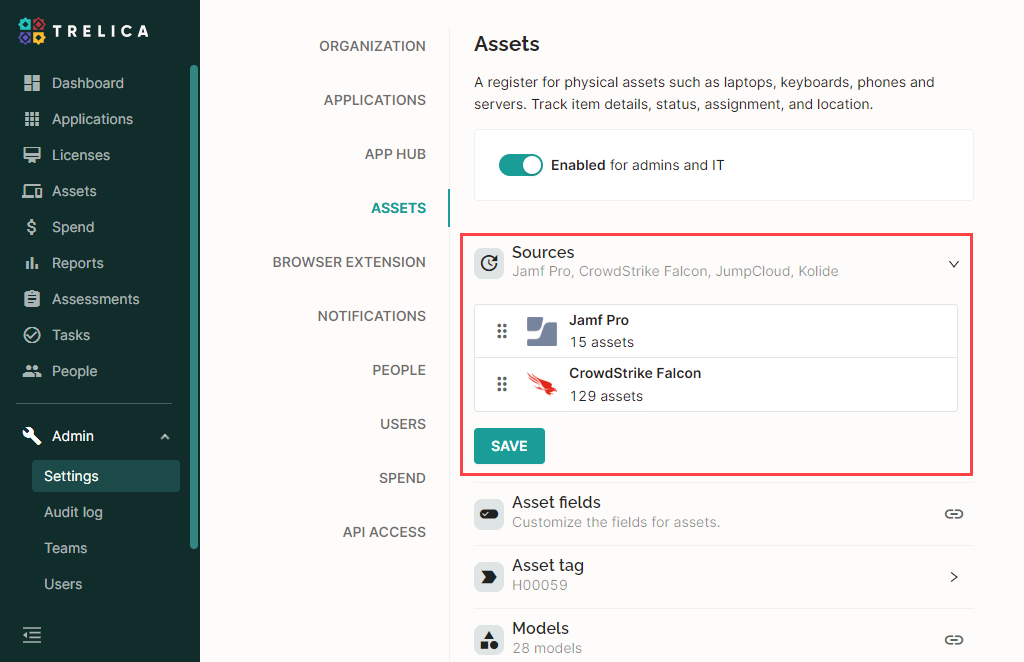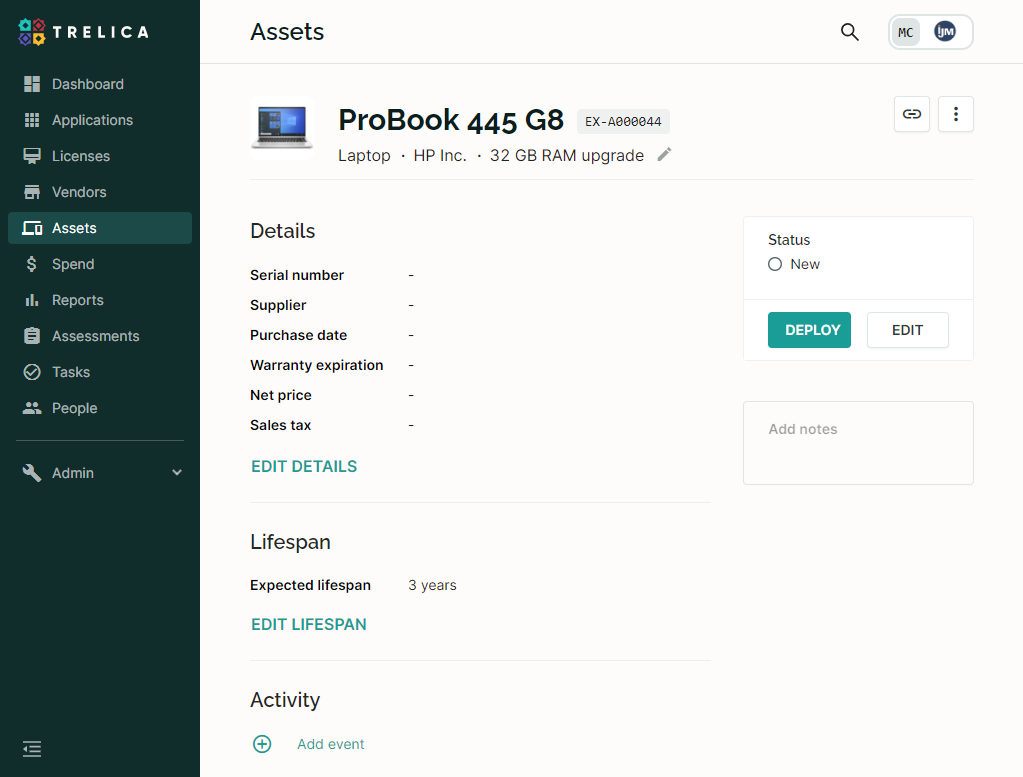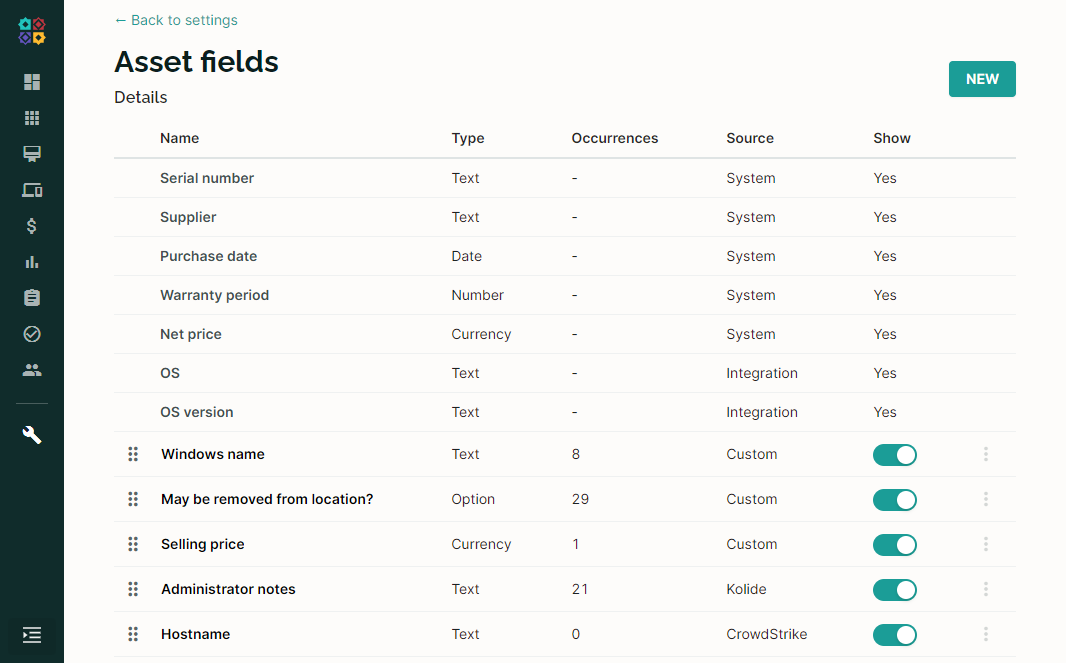If your organization is using a device or endpoint management system, you may be able to connect it to Trelica and populate your Device register automatically. You can also import device details from a spreadsheet or add devices manually.
Once you have added your devices, you can record additional details about them, set a lifespan, and record when they are deployed to individuals in your organization or otherwise change status.
You must be an admin or IT user to create and update devices.
Define the devices tag format
Each device that you add to Trelica must have a device tag. This is usually the unique identifier that your organization uses to keep track of all your devices (as opposed to the serial number, which is set by the manufacturer). You can use the device tag to search for a particular device in Trelica.
If you are importing device details via an integration with an external system or from a spreadsheet and a tag is not defined for each device in the source data, Trelica will assign tags automatically. Equally, when you add devices manually, the tag is set automatically.
You can define the format for device tags in Trelica to match your existing system. We recommend defining the device tag format and starting number before connecting to an external system or importing or adding devices manually.
To define the device tag format:
- Select Admin > Settings > Devices and click Device tag to expand the section.
- If required, enter a prefix for your device tags. The prefix can contain letters, numbers and special characters and is the same for every device.
- If required, set the starting number. When you create a new device, the device tag will default to the next number in the sequence.
- From the Length dropdown list, select the number of digits in the unique portion of the device tag (i.e. excluding the prefix).
- An example of the tag format is displayed below for confirmation. When you're ready, click Save to apply the device tag format to newly imported or added devices. Changing the default device tag format does not affect existing devices.

Connect Trelica to a device data source
Trelica supports integrations with Microsoft Intune, Jamf Pro, Kandji and other widely used endpoint management systems. You can connect Trelica to a supported system from the Integrations page. For more information, refer to the integration-specific help.
If the source system provides device details that do not map to the default device fields, Trelica will create custom device fields to store this information.
If required, you can connect to multiple endpoint management systems. If two or more systems contain details for the same devices and there are inconsistencies in the data, Trelica prioritizes based on the order in which the systems were connected.
You can override this behavior by changing the priority order of device source systems from the Device Settings page. Click Sources to expand the section and then reorder the sources as required.

Import devices manually
You can import device details from an Excel spreadsheet or .csv file. This is useful if your system does not expose an API that Trelica can connect to or if you're not currently using an external system to track your devices.
The file must specify the device model and manufacturer of each device. If a device tag is not specified for a device, Trelica applies a tag automatically based on the device tag format. Note that you cannot set values for custom device fields via an import.
To import device details:
- From the Device register expand the context menu and select Import. The Device imports wizard is displayed.
-
Select the file containing the data that you want to import and then click Next.
-
The Mapping step is displayed. Trelica attempts to map the fields in the file to fields in Trelica. To add or change mappings, click the drop-down boxes and select from the lists. Data from any fields that are not mapped is not imported.
- Device - The device model, such as the specific type of laptop, monitor or phone, as described by the manufacturer. Trelica will attempt to match the device model to our global library of device models. If a match is not identified, a custom model is added to your library of device models. For more information, see Manage device models below.
- Type - The category of device, such as laptop, monitor, keyboard or printer.
- Manufacturer - The name of the device manufacturer, such as HP or Dell.
- Status - Whether the device is new, ready, deployed, in repair or retired. By default, imported devices are set to "new". For more information about setting the device status, see Update and deploy devices.
- Trelica ID - The unique ID used by Trelica. This is distinct from the device tag. Only use this field if you are using an import to update existing devices.
- Serial number - The serial number provided by the manufacturer.
- Device tag - The unique identifier that your organization uses to keep track of all your devices. If device tags are not included in the spreadsheet, Trelica applies a device tag to each device in line with the defined format. For more information, see Define the device tag format above.
- Assigned to - The email address or name of the person to whom the device has been assigned. You can also set the assignee when you deploy a device. For more information, see Update and deploy devices.
- Location - The location of the device. You can also set the assignee when you deploy a device.
- For more information, see Update and deploy devices.
- Description - Details used to identify the device, such as the physical condition or size.
- Purchase date - Date on which the device was procured.
- Warranty expiration date - Date on which the manufacturer's warranty expires.
- Net price - Cost of the device in your site's default currency.
- Supplier - The company from which you procured the device.
- Expected lifespan - The period in months after which you expect to recondition or replace the device.
- Notes - Any additional information you want to record in the Device register.
- Once you have finished mapping the fields, click Import. The progress of the import and the number of devices added or updated as a result of the import are displayed.
To view the devices that have been imported, return to the Device register.
Add devices manually
You can either add devices to the Device register one at a time or create multiple devices of the same model in one go. The latter is useful if you have recently received a consignment of new laptops or phones, all with the same specification. When creating multiple devices, you cannot add deployment details; this information can be added to the individual devices after they have been created in bulk.

Custom device fields
You can define custom device fields in addition to the standard device fields from the Devices Settings. Custom fields are useful for recording additional information about devices, such as the tax paid, the device's operating system, or whether data stored on the device is encrypted. You can populate custom fields for individual devices from the device details page.
If you have connected Trelica to an endpoint management system to import device data automatically, any data that cannot be mapped to the default device fields is imported into custom device fields. You can choose whether to display these fields, change the order and edit the help text for each field from the Devices Settings.
Note that custom fields created as a result of an integration are not available for manually added devices.

Device models
Each device in your register must have a device model, such as the particular model of laptop, monitor or phone.
When you import device details from a spreadsheet or an external system, Trelica attempts to match each device to our global library of devices. If an appropriate match does not exist, a custom device model is created automatically.
When you add a device to Trelica manually, you are prompted to choose the relevant model from the library of existing devices. When you select a device from the list, the device type, manufacturer and image are pre-populated for you. If your device model is not listed, you can define a new device model. The model is added as a custom device model.
You can view the device models currently in use in your Device register, update custom device models, and search the global device library from the Devices Settings.

By default, only in-use models are displayed. Use the filters or select a different view to display other device models.
Use the context menu on each row to view the details of device models from the global library or edit the details of custom device models.
We're constantly adding new device models to the Trelica library. If a custom device model is subsequently added to our library, your model will be converted to a system model and will no longer be editable.
Next steps
If you have set up an integration to an external system, your Device register will be updated with details of new devices automatically. If you have imported or added devices manually, you will need to keep updating your Device register with details of new devices as you procure them. In either case, you can use Trelica to record additional details about devices keep track update and deploy individual devices.
Comments
0 comments
Please sign in to leave a comment.